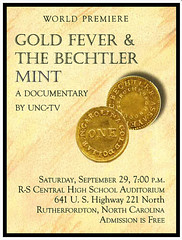
PREV ARTICLE
NEXT ARTICLE
FULL ISSUE
PREV FULL ISSUE
FILM: GOLD FEVER AND THE BECHTLER MINT
Last October we mentioned the newly established Tourism Asset Foundation [TAF] of Rutherford Co., NC, which plans to purchase the Bechtler House, home of pioneer gold coin maker Christopher Bechtler. Dick Hanscom forwarded information about a film made by UNC-TV of Research Triangle Park, NC titled "Gold Fever and the Bechtler Mint". Thanks! DVDs of the film are available for sale, and I would encourage collectors, researchers and research libraries to obtain a copy. Here's some information form the film's web site.
-Editor
The Beginnings Of NC’s Gold Rush Reed, soon realizing that he had been swindled, aligned himself with partners in a crude mining operation at the site of his son’s find. The men scoured the banks and sandbars of nearby rivers and streams using picks, shovels, pans and possibly a rudimentary rocker device to separate the heavy gold particles from the lighter sand and debris. For 20 years following the discovery of gold on Reed’s farm, miners, many of whom were smalltime farmers, sifted through sand and gravel along NC’s streams and rivers. Because surface mining takes only simple equipment, a shovel and pan, or a crude rocker, prospectors came from all across the state as well as from surrounding areas to try their luck and seek their fortune.
Where’s The Gold? In 1825, Mattias Barringer, another German whose farm was about 20 miles from the Reed farm, followed a vein of surface gold down to the gold-bearing rock. The Barringer Gold Mining Company was the first of many in the Charlotte area to try deep vein mining. Subsurface mining required far more equipment and technical skill than placer mining. Within a few years, dozens of companies had been formed to work the deeper gold deposits. The discoveries and excitement continued to mount. Production increased as experienced miners and engineers arrived from European and South American mines. By 1832, more than fifty mines were operating in NC, employing more than 25,000 people. Next to farming, more people were employed in gold mining than in any other enterprise. In 1837, English geologist George Featherstonhaugh visited several NC gold-mining operations between Rutherford and Mecklenburg Counties. He was distressed by the destruction of the land wherever placer mining was taking place, and observed that heedless removal of topsoil in the quest for gold ruined the land for future agricultural uses.
Problems Facing Miners & Prospectors Southern prospectors who were lucky enough to find gold had no reliable market for it. The only U.S. Mint was in Philadelphia - a long, dangerous journey away. There were few roads and fewer bridges. Travel was uncomfortable and unreliable. Much of the gold found by well-organized companies could be shipped through Charleston to Europe more reliably than it could be sent to Philadelphia.
The film runs about 26 minutes and is available in full on the web site.
-Editor
Rutherford County Historian Robin S. Lattimore (who appears in the film) writes: You may purchase copies of the Bechtler documentary produced by UNC-TV by sending a check for $20 (includes shipping) made payable to the Rutherford County Historical Society.
RCHS
Attn: Robin S. Lattimore
To read the complete article, see: Gold Fever and the Bechtler Mint (goldfever.unctv.org/)
To read the earlier E-Sylum articles, see:
The Numismatic Bibliomania Society is a non-profit organization promoting numismatic literature. See our web site at coinbooks.org. To submit items for publication in The E-Sylum, write to the Editor at this address: whomren@gmail.com To subscribe go to: https://my.binhost.com/lists/listinfo/esylum All Rights Reserved. NBS Home Page Contact the NBS webmaster 
|
